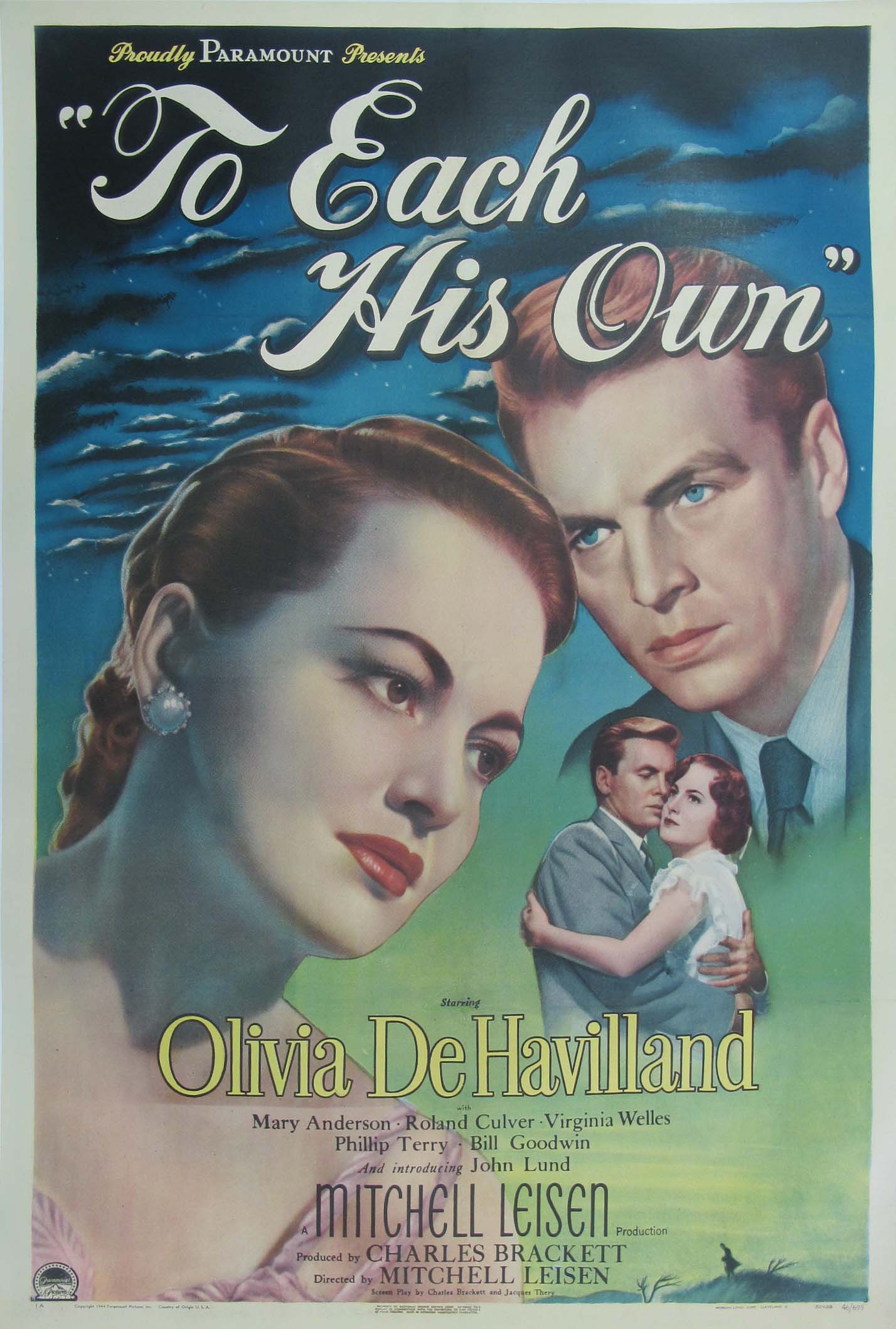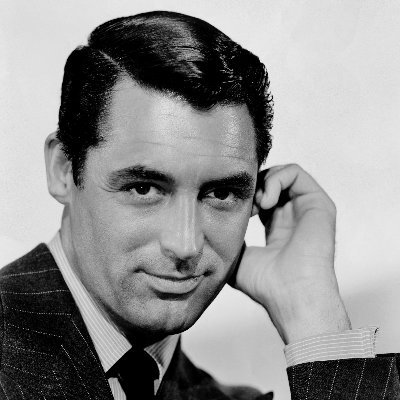
- Starring
- Olivia de Havilland, John Lund, Mary Anderson
- Writers
- Charles Brackett, Jacques Théry
- Director
- Mitchell Leisen
- Rating
- n/a
- Running Time
- 122 minutes
Overall Score
Rating Summary
To Each His Own follows a young woman named Josephine “Jody” Norris (de Havilland) who bears a child out of wedlock. She makes a gamble to give up the baby boy to a family with too many children of their own and “adopt” him to avoid scandal, but this backfires when Corinne (Anderson), wife of Alex Piersen (Philip Terry), one of Jody’s unrequited loves, loses her own baby, named Gregory, and takes Jody’s child as her own. At various points she tries to insert herself into her son’s life to no avail, and has to watch him grow up as part of a different family.
From the start, the film takes a familiar story where our reluctant protagonist tells their story in flashbacks, but this set-up is exceedingly well-thought from the start; Jody begins the movie acting aloof and distant, but increasingly opens up and reveals herself to be very kind and compassionate. Her face is hard to read yet you can already sense a long troubled history behind her. She is naturally beautiful as she always has been, but she’s also visibly worn and jaded, and it takes Lord Desham (Roland Culver) showing her unconditional empathy and understanding for her to shed the shield her emotions hide behind. This is when she starts retelling her past.
Jody’s life, starting in her young adulthood, is full of strife and hardship, as well as some mistakes of her own, beginning with a short-lived romance with a US Army Air Service fighter pilot Bart Cosgrove (Lund), and when Cosgrove is killed her action, she chooses at the last moment to carry through with her pregnancy, only to have give the baby up. Throughout the story we see her make shrewd decisions to keep herself afloat socially, and hopefully reunite with her lost son. Some of the plot turns can border on ludicrous, as is the case with many melodramas from the 1940s and 1950s, but this is one of the more successful ones in that it doesn’t force you to focus too much on the absurdity of the premise or certain plot beats and it simply trusts you to go along for the ride. This brings us to our heroine of sorts, Jody Norris, who is an easy character to identify with. The mistakes she makes, if sometimes playing to the more absurd elements of the film, are still achingly human and relatable to the audience, and it is fulfilling to see her find success in life, such as opening a thriving cosmetics business from a broken bootlegging booth.
And like the best melodramas, the characters drive the plot of To Each His Own and not the other way around; this especially applies to Jody, played phenomenally by de Havilland in one of her best performances. What was most striking was how most is how she modulates every whirlwind of emotion she has to portray. It never once felt like she was overplaying anything, even when the movie called on her to cry and get angry, easy emotions to go over-the-top with. She’s also convincing as both the aged spinster who tells her tale with the benefit of hindsight and the youthful belle who kickstarts the story, as well as the calculating young woman trying to overcompensate for her past mistakes. The less-known supporting cast also do a fine job as adversaries, if not on de Havilland’s level. Anderson especially is compelling as Corinne, whom viewers can tell is lacking enough people in her life who truly love her, this includes her husband. As such, she’ll do anything to keep Gregory, who is an exception to this. If there’s a weak link, it was Lund, who doesn’t really make much of a lasting impression, let alone convince as both Cosgrove and the young adult Gregory Pierson (odd double-casting choice by the way).
In its essence, director Mitchell Leisen and screenwriters Charles Brackett and Jacques Thiery want to carefully study Jody as a main character, flaws, fine points and all. And without the acidic cynicism of their frequent collaborator Billy Wilder, they are instead straightforwardly sincere in their efforts. And again, it works because there is a concrete through line of rise-and-fall-and-rise-again that informs Jody’s narrative. Viewers see her get herself out of the messes she’s gotten herself into, and have to grow to understand things that weren’t so easy for her to understand before. That moment when her four-month-old son rejects her after a couple weeks together because he misses Corinne, and she has to realize that being a mother means to be emotionally available for the child, nurturing them during sickness, and making them feel supported, is a powerful and heartbreaking moment, tying together the underlying theme of motherly love. In general, the movie’s understanding of Jody’s flaws becomes universal in how her insecurities feel so real and true to life. Most people can relate to fearing that people think the worst of them, even at their most ostensibly self-confident. This gives many opportunities for Leisen to focus on de Havilland’s pensive, conflicted face and show us how she’s feeling without letting the script make it too obvious for the audience. It’s one of his fine traits that made him so dependable, and unendingly underrated, as a director in the Golden Age of Hollywood.
Speaking of Leisen’s direction, To Each His Own looks and sounds sweeping, romantic and melodramatic as it should. The production design reflects the timeline stretching from World War I, to probation, to the Roaring ’20s, and finally to World War II, complete with clever details about what characters were going throughout all of this. The interiors of the houses feel expansive and wealthy, while dingier places like the bar feel appropriate in their dirtier, rougher design. Daniel Fapp’s cinematography is subtle but effective, again capturing de Havilland’s face marvelously, as well as the rosy glory of the home of Jody’s youth, as well as the nighttime of the later scenes in all its fog and glowing lamps. Victor Young’s score goes big and compels you to feel whatever emotion the movie is establishing, but it’s never quite overbearing and it’s wistful and moody as it should be. Alma Macrorie’s editing also has some neat tricks to share, keeping the film moving at an agreeable pace and focusing on the right things at the right time.
In the end, those looking for a prime example of what sheer craftsmanship can do, where everyone is working to create a fully satisfyingly product, or if you’re just looking to become more immersed in the melodrama genre, look no elsewhere than To Each His Own . One of the better examples of the Old Hollywood melodrama, the film is anchored by universal themes and an all-encompassing performance from Olivia de Havilland.
still courtesy of Paramount Pictures
Follow me on Twitter, Instagram, and Letterboxd.
If you liked this, please read our other reviews here and don’t forget to follow us on Twitter or Instagram or like us on Facebook.
Discover more from
Subscribe to get the latest posts sent to your email.

